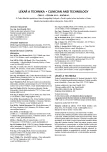AUTOMATIC SEGMENTATION OF PHONEMES DURING THE FAST REPETITION OF (/PA/-/TA/-/KA/) SYLLABLES IN A SPEECH AFFECTED BY HYPOKINETIC DYSARTHRIA
Hypokinetic dysarthria is a common manifestation of Parkinson's disease (PD). Articulation characteristics can provide useful information to distinguish dysarthric speakers from healthy subjects and monitor the severity of disease and treatment effects. The aim of this study was to design an algorithm for automatic segmentation of consonants and vowels based upon a rapid steady /pa/-/ta/-/ka/ syllable repetition. All syllables were manually labeled at three positions including explosion (E), vowel (V), and occlusion (O). In addition, the representative measurement of voice onset time (VOT) was included as difference between V and E position. When compared to the manual labeled positions, the VOT is detected within the range 5ms to 20ms with a range of a success rate of 68.2 - 90.5%, 44.1 - 75.2%, and 57.2-83.5% for normal, dysarthric, and all speakers. In conclusion, this study shows that algorithm based on the spectral, Bayesian, and polynomial approaches, that can be used to accurately detect the positions of consonant and vowels in normal and dysarthria-related utterances.
Keywords:
Parkinson’s disease, dysarthria, articulation, diadochokinetic
Autoři:
Michal Novotný; Jan Rusz; Roman Čmejla
Působiště autorů:
Czech Technical University, Faculty of Electrical Engineering, Prague, Czech Rep.
Vyšlo v časopise:
Lékař a technika - Clinician and Technology No. 2, 2012, 42, 81-84
Kategorie:
Conference YBERC 2012
Souhrn
Hypokinetic dysarthria is a common manifestation of Parkinson's disease (PD). Articulation characteristics can provide useful information to distinguish dysarthric speakers from healthy subjects and monitor the severity of disease and treatment effects. The aim of this study was to design an algorithm for automatic segmentation of consonants and vowels based upon a rapid steady /pa/-/ta/-/ka/ syllable repetition. All syllables were manually labeled at three positions including explosion (E), vowel (V), and occlusion (O). In addition, the representative measurement of voice onset time (VOT) was included as difference between V and E position. When compared to the manual labeled positions, the VOT is detected within the range 5ms to 20ms with a range of a success rate of 68.2 - 90.5%, 44.1 - 75.2%, and 57.2-83.5% for normal, dysarthric, and all speakers. In conclusion, this study shows that algorithm based on the spectral, Bayesian, and polynomial approaches, that can be used to accurately detect the positions of consonant and vowels in normal and dysarthria-related utterances.
Keywords:
Parkinson’s disease, dysarthria, articulation, diadochokinetic
Zdroje
[1] Rodríguez-Oroz, M., C., Jahanshahi, M., Krack, P., Macias, R., Bezard, E., Obeso, J., A.: Initial clinical manifestations of Parkinson’s disease: features and pathophysical mechanisms. The Lancest Neurology, 8 (12), 1128 – 1139,2009.
[2] Duffy, J., R.: Motor Speech Disorders: Substrates, Differential Diagnosis and Management. 2nd ed. Mosby, New York, NY, 2005 pp. 1 – 592.
[3] Darley, F., L., Aronson, A., E., Brown, J., R.: Differential diagnostics patterns of dysarthria. J. Speech. Hear. Res., 12, 426 – 496,1969.
[4] Rusz, J., Čmejla, R., Růžičková, H., Růžička, E.: Quantitative acoustic measurements for characterization of speech and voice disorders in early untreated Parkinson’s disease. J. Acoust. Soc. Am., 129 (1), 350 – 367,2011.
[5] Fletcher, S.: Time – by – count measurement of dyadochokinetic syllable rate. J.Speech. Hear. Disord., 15, 757 – 762, 1972.
[6] Čmejla, R., Sovka, P.: Recursive Bayesian Autoregressive Changepoint Detector for Sequential Signal Segmentation. EUSipco Proceeedings, Wien (2004), 245 – 248.
[7] Hansen, J., H., L., Gray, S., S., Kim, W.: Automatic voice onset time detection for unvoiced stops (/p/, /t/, /k/) with application to accent classification. Speech Comunication, 52, 777 – 789, 2010.
[8] Stouten, V., Van Hame, H.: Automatic voice onset time estimation from reassignment spectra. Speech Communication, 51, 1194 – 1205, 2009.
Štítky
BiomedicínaČlánok vyšiel v časopise
Lékař a technika

2012 Číslo 2
Najčítanejšie v tomto čísle
- MECHANICAL MODEL OF THE CARDIOVASCULAR SYSTEM: DETERMINATION OF CARDIAC OUTPUT BY DYE DILUTION
- MATLAB AND ITS USE FOR PROCESSING OF THERMOGRAMS
- The Fifth Biomedical Engineering Conference of Young Biomedical Engineers and Researchers
- VALUATION METHODOLOGY FOR MEDICAL DEVICES
